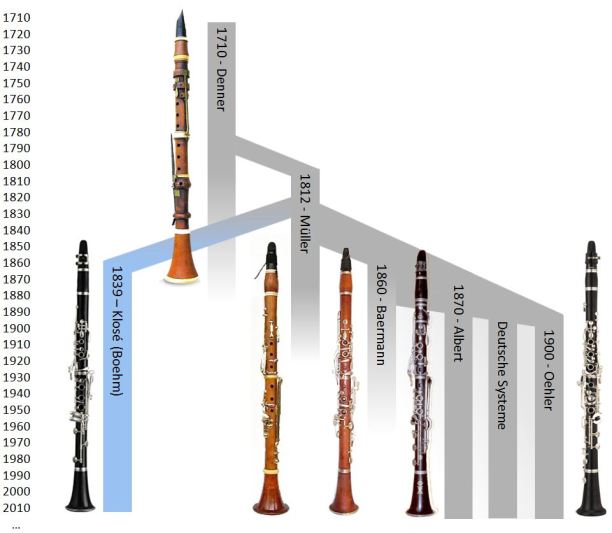From its origin in the eighteenth century, the clarinet, as any other instrument, has experienced many manufacturing changes in order to pursue accuracy in tone, tuning and more flexibility of the fingering positions.
Not every clarinettist is aware of the diverse amount of models and systems that currently exist in the market but I believe it is essential to know the evolution and consequences that these systems have developed. The author has no afiliation with any manufacturer. The intention of this article is for education purposes and will remain neutral throughout.
History
To begin with I would like to define the word ‘system‘, which in this case relates to the fingering positions, mechanism, bore dimension and material that clarinets have been produced with. It is worthwhile mentioning a bit of history regarding this instrument in order to understand the influence that our current instrument makers have been experiencing through the years.
The clarinet was a revolutionary development around 1700, built as an evolution of the chalumeau, which was considered a shepherd’s instrument. Unfortunately it is not possible to find any chalumeau nowadays but it is said that its sound resembled to the lower octave of today’s clarinet, as it couldn’t produce any upper register sound (from this we use the term ‘chalumeau register’ to refer to the lower register of the clarinet).
The first clarinet was created around 1710 by the instrument maker J. C. Denner of Nuremberg, Germany. After experimenting with chalumeau clarinets, he managed to build an instrument that could play in both lower and higher registers than the chalumeau. These clarinets were still very simple and looked a lot like a large recorder.
Since then, the next noticeable change was made by the German clarinettist Iwan Müller, who revolutionised the clarinet mechanism into a 13-key system in 1812. He introduced the new spoon-key with leather pads and developed the ligature, among other things.
Shortly after this, the French clarinettist Hyacinthe Klosé developed the ‘Boehm’ clarinet model and his instrument maker Buffet started building it in 1839. This clarinet was based upon the revolutionary instrument design that the German flute maker Theobolde Boehm was pursuing at that time. It had perfectly calculated positions of the tone holes and included the ring key. Klosé introduced his instrument to the Parisian Music Academy, who accepted it, and it soon became one of the most played systems in the whole world, which it still is today.
Alongside this, instrument makers from German speaking countries would still try to improve Müller’s system, pursuing a greater agility and flexibility in playing. It is said that Baermann, a clarinet virtuoso during the Romantic era, was an exponent of a new style of playing consisting of placing the mouthpiece with the reed resting on the bottom lip (as is done today), as opposed to the top lip as had been the previous style. His instrument was a bit more modern, made by Griesling & Schlott around 1860, which allowed him to play chromatic passages with far greater ease.
A new derivative of Müller’s 13-key system was created by Eugène Albert in 1870, which therfore would be called the Albert System. This clarinet included some unkeyed tone holes, allowing to play slurred notes with ease.
The last and current version of the German system was developed around 1900 by Oskar Oehler, also based on Müller’s clarinet system. The Oehler system clarinet has more keys than the Boehm system, as well as narrower bore, and a longer and narrower mouthpiece.
The next picture shows a clear evolution of the clarinet in a simplified way:
